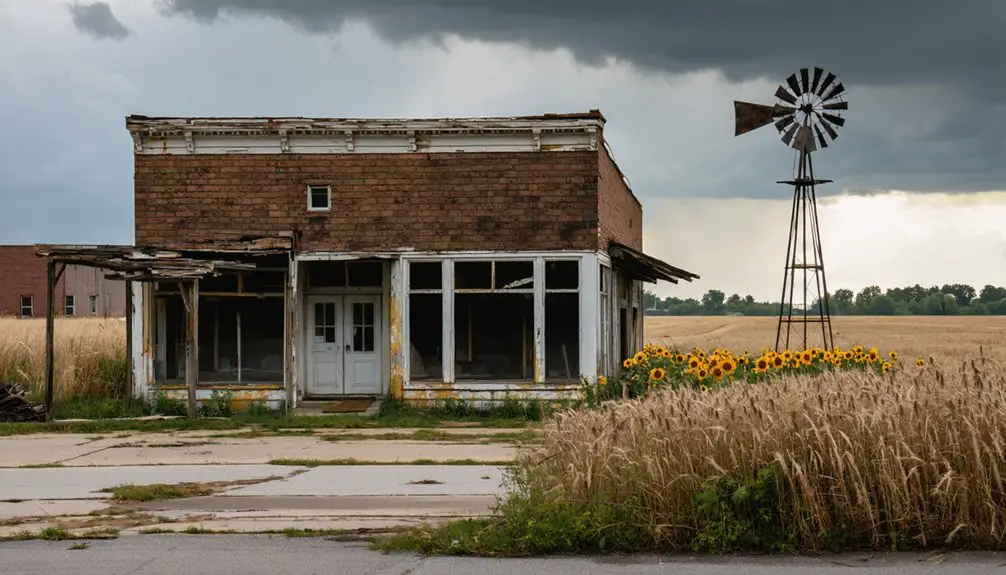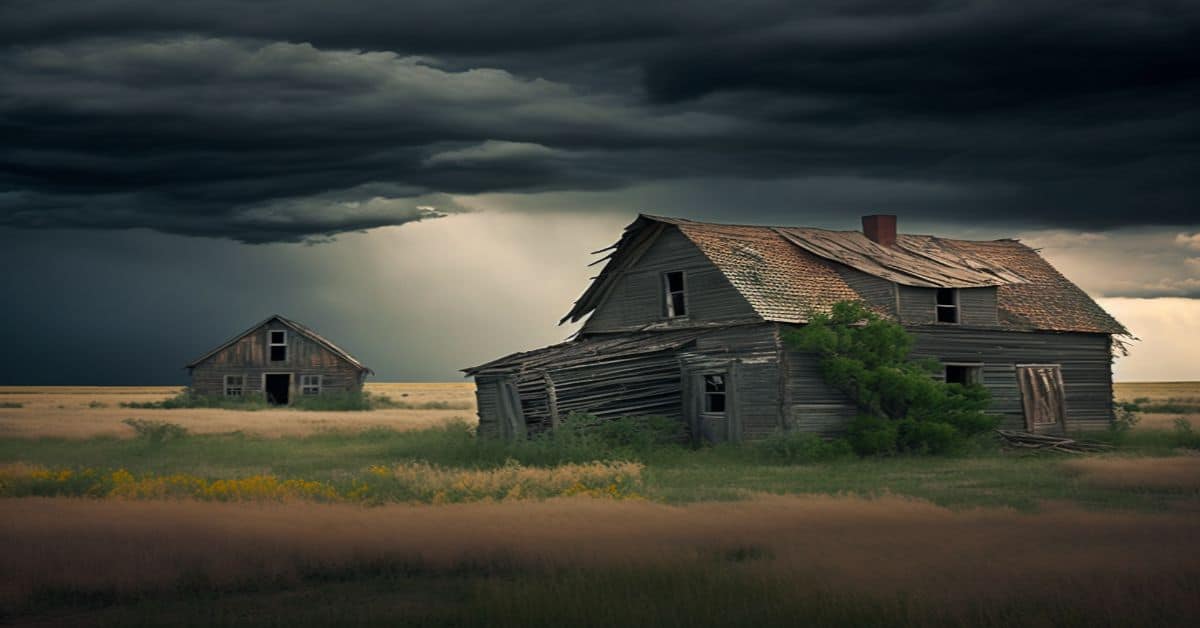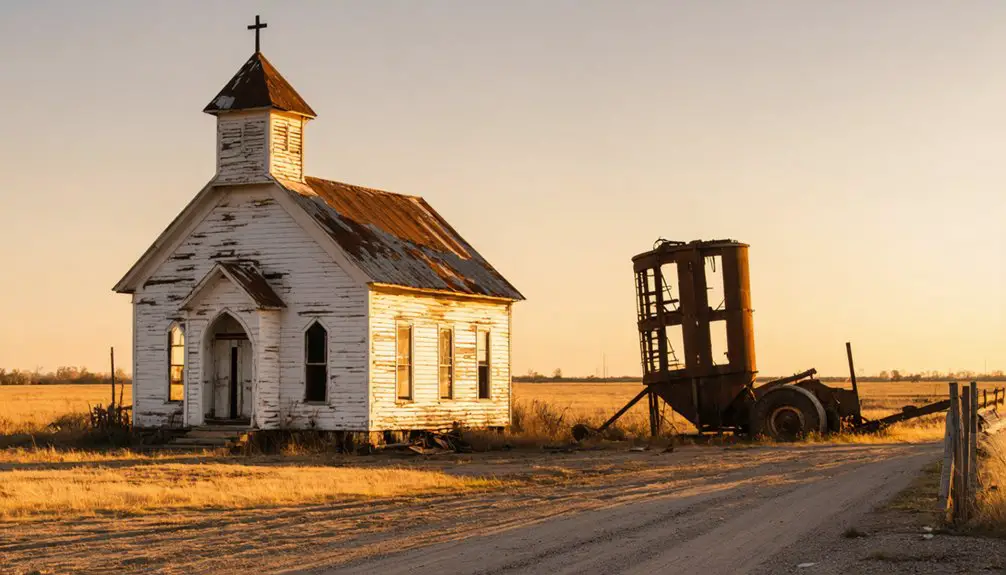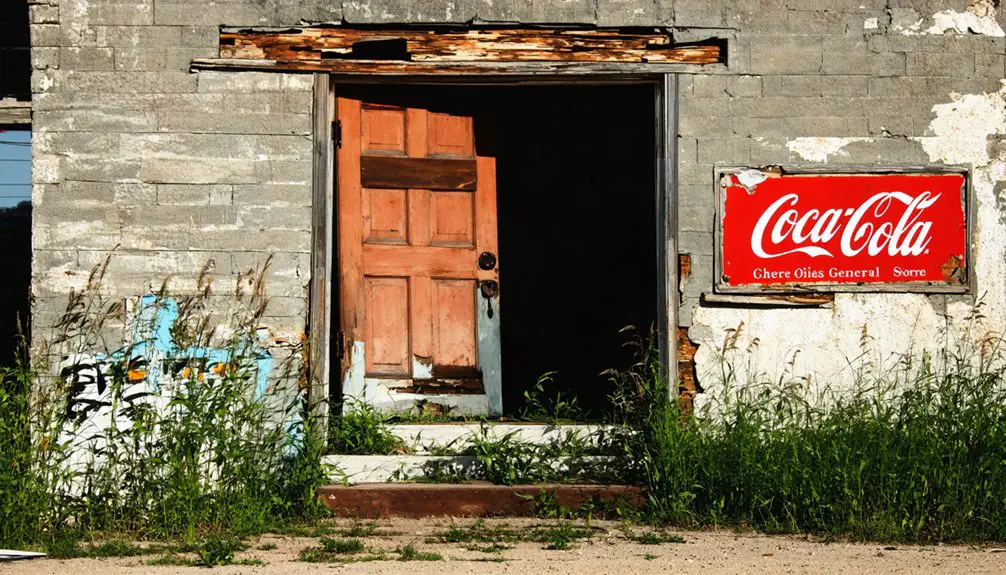You’ll discover a vanished frontier dream in Magee, Oklahoma, founded by Wally McGee in 1885. This once-thriving agricultural hub boasted twenty retail establishments by 1905, including McGee’s blacksmith shop, Long’s general store, and the First Bank of McGee. When promised railroad connections never materialized, residents faced economic hardship and migration pressures. By the 1930s, foreclosures and mechanization pushed families westward, leaving behind a ghost town whose story captures the harsh realities of frontier settlement.
Key Takeaways
- Founded in 1885 by Wally McGee, the town grew to twenty retail establishments by 1905 before its eventual decline.
- The absence of a promised railroad connection led to economic isolation and population exodus from Magee.
- The Great Depression in the 1930s devastated Magee with high foreclosure rates and forced many residents to relocate.
- Residents migrated westward, primarily to California, following Route 66 in search of better agricultural and economic opportunities.
- The town’s buildings and businesses were eventually relocated to nearby Stratford, leaving Magee abandoned as a ghost town.
The Pioneer Vision of Wally McGee
One ambitious pioneer shaped the destiny of Magee, Oklahoma through his entrepreneurial vision and determination. In 1885, Wally McGee brought his pioneering spirit to Indian Territory, where he’d transform a sparsely settled area into a thriving community.
You’ll find McGee’s entrepreneurial journey began in 1891 with a blacksmith shop, which served as the cornerstone of early development. His vision expanded rapidly as he established a sawmill and the area’s first cotton gin in 1892, strategically using a natural rain-formed pond for operations. W.J. Long helped advance the town’s commerce by constructing the first dry goods and grocery store. The town’s first educational milestone came when a subscription school was established in a brush arbor in 1893.
McGee’s initiatives sparked a chain reaction of growth, with other businesses clustering around his original establishments. Though the town was briefly considered to be named “Walling,” it ultimately honored its founder, becoming known as McGee.
Early Business and Commerce
Three pivotal businesses laid the foundation for McGee’s commercial district in the early 1890s: W.W. McGee’s blacksmith shop, W.J. Long’s general store selling Springfield wagons, and McGee’s sawmill with cotton gin.
McGee’s commercial core began with three vital enterprises: a blacksmith shop, a wagon-selling general store, and a combined sawmill-cotton gin operation.
These early trade ventures served the growing community’s essential needs. Like many Oklahoma towns that eventually became ghost town sites, McGee showed great initial promise.
The town’s retail establishments expanded steadily, reaching twenty businesses by 1905. You’d have found A.C. Cromer’s store offering Studebaker wagons, King’s adjacent shop, and Houston Byford’s store among the later additions. McCombs’ barber shop, opened in 1899, provided grooming services to local residents.
Agricultural commerce thrived through the cotton gin and wagon sales, while the First Bank of McGee opened in 1903 to support local trade.
Despite this promising growth, McGee’s wooden business district wouldn’t last. By 1907, economic decline led to building relocations, marking the end of the town’s commercial heyday.
Daily Life in a Frontier Town
Beyond the business district’s wooden storefronts lay the heart of McGee’s frontier community. You’d find families living in simple log cabins, built from local timber and designed to withstand harsh prairie conditions.
Despite frontier challenges, residents created a tight-knit community through shared spaces and seasonal gatherings.
Your daily routine would’ve centered around three essential aspects:
- Self-sufficiency – drawing water from wells, chopping wood for heat, and maintaining your homestead
- Community support – gathering at churches, sharing medical resources, and helping neighbors during emergencies
- Seasonal rhythms – adapting to agricultural demands, weather patterns, and trading cycles
This community resilience helped residents overcome isolation and limited infrastructure, though they remained vulnerable to economic shifts and natural hardships that eventually led to the town’s decline.
Like many Oklahoma towns facing natural disasters, floods and tornadoes frequently threatened the community’s stability.
Like many Oklahoma towns, the collapse of gypsum mining operations in the region contributed significantly to the community’s eventual abandonment.
Railroad Dreams and Broken Promises
You’ll find that Magee’s residents pinned their economic hopes on securing a crucial railroad connection during Oklahoma’s early rail expansion boom.
When the promised rail line failed to materialize, the town’s merchants and farmers watched helplessly as trade and commerce shifted to better-connected communities to the south.
The Santa Fe Railway had already established control over major rail routes in the region by 1914, leaving many small towns isolated from vital transportation networks.
By 1910, over six thousand miles of rail crossed Oklahoma’s landscape, making towns without railroad connections increasingly obsolete.
The denial of railroad access ultimately triggered a population exodus that would seal Magee’s fate as businesses and families relocated to towns with established rail service.
Railroad Access Denied
While many Oklahoma towns flourished with the arrival of railroads in the early 1900s, Magee’s story reflects the harsh reality of being bypassed by major rail lines.
The railroad expansion that transformed Oklahoma’s landscape created stark economic disparity between connected and isolated communities. The Oklahoma Central Railroad contributed to this pattern by prioritizing coal transport routes between strategic points like Lehigh and Chickasha. Similar to the AT&SF Railway, established rail companies focused on profitable mainline routes.
You’ll find three critical factors that sealed Magee’s fate:
- Major rail companies like MKT and Atlantic & Pacific chose routes based on profitable resource extraction, leaving smaller settlements disconnected.
- Exclusive rights granted to dominant railroads prevented local communities from building their own connecting lines.
- Without rail access, Magee couldn’t attract industrial investment or participate in the region’s agricultural market growth.
The town’s isolation from rail networks ultimately contributed to its decline, demonstrating how transportation access shaped the destiny of early Oklahoma communities.
Population Migration South
As families across southeastern Oklahoma faced mounting economic pressures in the 1930s, Magee and its neighboring communities experienced a dramatic population exodus that surpassed even the well-documented Dust Bowl migration.
You’ll find that migration motivations stemmed from a perfect storm of economic challenges: foreclosure rates hit 10% between 1931-1933, while mechanization and new agricultural policies pushed tenant farmers off their land.
Family networks in California and other southwestern states beckoned with promises of opportunity, leading to an exodus that drained Magee’s significance. When landowners took fields out of production and the Agricultural Adjustment Administration‘s incentives further reduced farming opportunities, you couldn’t blame folks for seeking better prospects elsewhere.
The result? Magee’s population plummeted, leaving behind an aging community and a weakened local economy.
The Great Building Migration
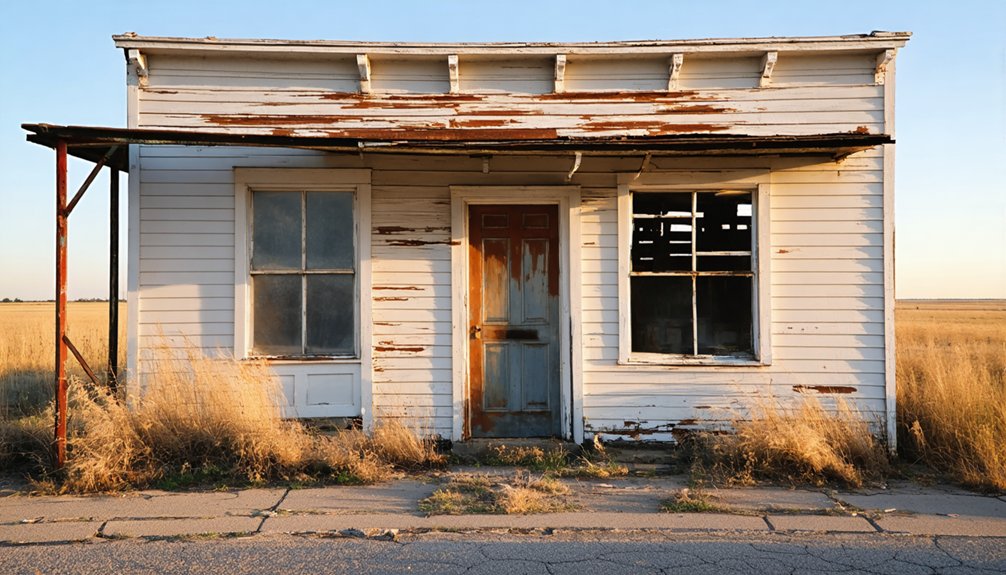
During the Great Depression, a massive exodus of approximately 440,000 Oklahomans transformed the state’s demographics, with most heading westward in search of better opportunities.
You’ll find that this building migration wasn’t just about people leaving – it represented the dismantling of entire communities as families sought survival elsewhere.
The era’s community resilience manifested in three distinct ways:
- Tenant farmers adapted by following Route 66 to California’s agricultural regions.
- Displaced workers formed new communities in migrant camps and FSA settlements.
- Families maintained social connections across states to help others relocate.
The economic pressures and mechanization of farming left many with no choice but to dismantle their homes and rebuild their lives elsewhere, particularly in California’s San Joaquin Valley, where they faced both challenges and opportunities for renewal.
Environmental Forces and Natural Resources
In the harsh grasslands of Oklahoma, Magee’s success hinged on reliable access to water resources for both household use and agricultural needs.
You’ll find that the community’s wells and water sources determined where settlers could establish viable farmsteads across the prairie landscape.
The area’s rainfall patterns and periodic droughts shaped the timing of crop plantings and ultimately influenced whether local families could sustain their agricultural ventures.
Prairie Water Resources
The essential prairie water resources surrounding Magee played an important role in shaping the area’s ecosystem and agricultural development.
You’ll find that the interaction between surface water and groundwater created a complex watershed system that sustained both the natural environment and farming activities. Prairie conservation efforts focused on protecting these essential water resources while maintaining water quality for the community.
Three key aspects defined Magee’s water resources:
- Surface runoff patterns varied between native tallgrass prairie and crop-livestock areas
- Local aquifers provided critical baseflow to streams during dry periods
- Sediment and nutrient transport greatly impacted stream health and water quality
Understanding these dynamics helped residents adapt their land management practices to preserve their water resources while maintaining agricultural productivity.
Weather-Dependent Agricultural Success
Weather patterns dramatically shaped agricultural success in Magee, where farmers contended with unpredictable rainfall cycles and harsh prairie conditions.
You’d find cotton thriving in warm seasons, but crop resilience suffered during frequent drought periods. Your success depended heavily on seasonal rains collecting in ponds for processing at local cotton gins.
Rainfall variability created constant challenges for your farming operations. When dry spells hit, you’d face failing harvests and economic hardship.
Even in wet years, you’d battle flooding that damaged crops and washed away precious topsoil. Prairie winds could devastate young plants, while frost dates restricted your growing season.
These environmental pressures ultimately forced many farmers to relocate to nearby railroad towns like Stratford, where more sustainable conditions prevailed.
Cultural and Social Foundations
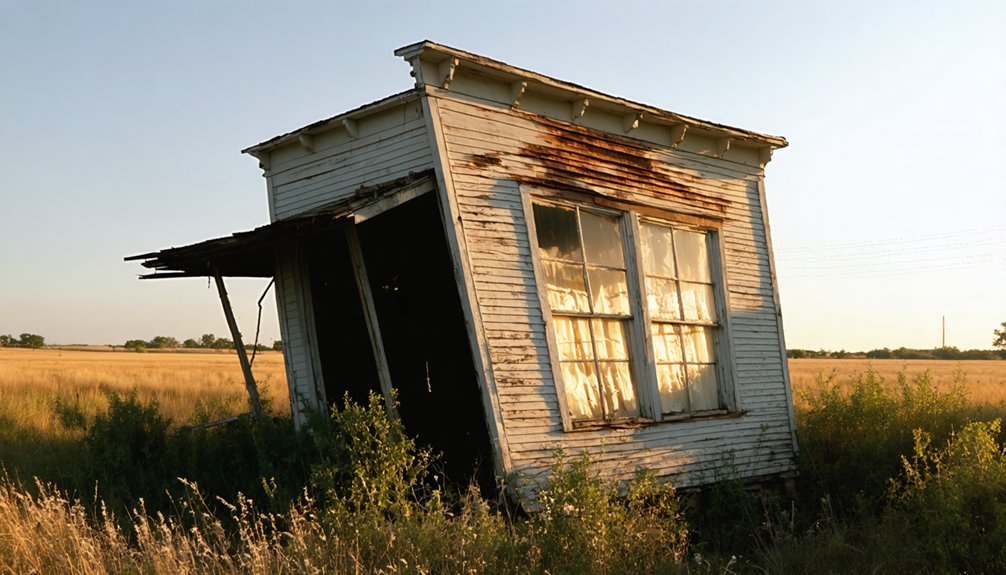
Founded in 1891 by William Wallace “Wally” McGee, this frontier community quickly established a robust social framework centered around commerce and civic organizations.
You’ll find the Masonic Lodge served as a cornerstone for community gatherings and social networks, with Sam Richards and W.J. Long providing leadership as worshipful master and secretary.
The town’s cultural fabric was woven through three key elements:
- Family-operated businesses like Griffin’s store that created economic and social bonds
- Professional services from Dr. Laird and Dr. Cullum that brought healthcare to the frontier
- Social spaces including barber shops and hotels that fostered daily interactions
Despite limited formal institutions, McGee’s residents maintained social order through personal relationships and shared commerce venues until the town’s eventual relocation to Stratford.
Legacy in Oklahoma’s Settlement History
Beyond its social foundations, McGee left an indelible mark on Oklahoma’s settlement patterns and economic development.
You’ll find its legacy in the town’s pioneering role as an agricultural hub and its dramatic response to changing settlement dynamics when the Frisco Railway bypassed the community. The town’s economic resilience was tested as entire buildings and businesses physically relocated to nearby Stratford, demonstrating how frontier communities adapted to survive.
McGee’s 16-year lifespan captures the essence of boom-and-bust cycles common in Indian Territory, while its infrastructure development – from blacksmith shops to medical services – laid groundwork for future regional growth.
Today, McGee’s story serves as a powerful reminder of how transportation corridors shaped Oklahoma’s early development and community survival.
Frequently Asked Questions
What Happened to Wally Mcgee After the Town Was Abandoned?
After McGee’s 1907 abandonment, you’ll find Wally relocated to Avoca near Asher, Oklahoma, where his brother Sam served as Masonic Lodge Master. Beyond that move, Wally’s legacy fades into McGee memories.
Were There Any Deaths or Burials Recorded in Mcgee’s Short History?
You’ll find only one documented death: A.Y. “Yoke” Griffin was killed by Dr. J.N. Norris in self-defense. No official burial sites or death records survive from McGee’s brief history.
Did Any Native American Families Live Within the Town of Mcgee?
While records don’t definitively show Native American families within McGee’s borders, you’ll find their cultural influence woven through the region like threads in a blanket, with nearby tribal allotments suggesting possible residence.
What Was the Highest Population Mcgee Reached During Its Existence?
You’ll find that McGee’s highest population never exceeded 100 residents during its peak town growth period around 1900, though exact numbers weren’t officially documented in historical records.
Did Mcgee Have a Post Office During Its Sixteen Years?
You’ll find McGee’s postal service operated for all sixteen years, opening April 15, 1891 as the town’s third business. Its historical significance lasted until 1907 when operations shifted to nearby Stratford.
References
- http://mcgeeindianterritory.weebly.com/history-of-mcgee.html
- http://genealogytrails.com/oka/garvin/towns.html
- https://en.wikipedia.org/wiki/List_of_ghost_towns_in_Oklahoma
- https://dp.la/item/9ed192696801aa6d30516a82e166de04
- http://mcgeeindianterritory.weebly.com/history-of-mcgee-cont.html
- https://www.findagrave.com/memorial/30771086/william-wallace-mcgee
- https://ancestors.familysearch.org/en/K8TJ-P29/john-magee-1883-1968
- https://www.okhistory.org/publications/enc/entry?entry=GH002
- https://www.youtube.com/watch?v=5d-wHDTIbb0
- https://www.kosu.org/local-news/2014-05-23/ghost-towns-all-black-oklahoma-towns
